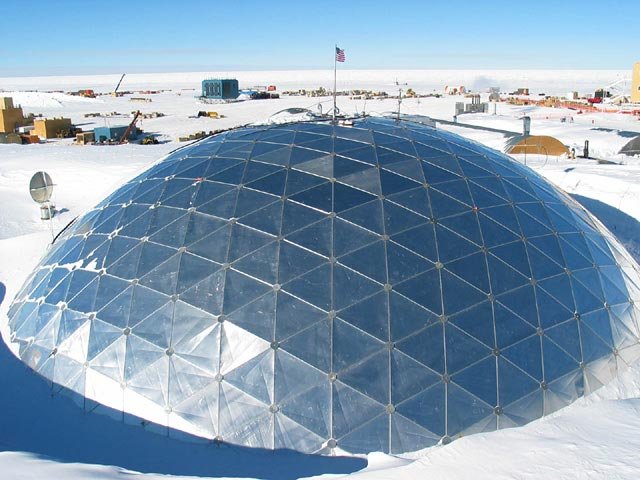Buckminster Fuller is best known for the invention of the geodesic dome, the lightest, strongest, and most cost-effective structure ever devised. The geodesic dome is able to cover more space without internal supports than any other enclosure. It becomes proportionally lighter and stronger the larger it is. The geodesic dome is a breakthrough in shelter, not only in cost-effectiveness, but in ease of construction. In 1957, a geodesic dome auditorium in Honolulu was put up so quickly that 22 hours after the parts were delivered, a full house was comfortably seated inside enjoying a concert. Today over 300,000 domes dot the globe.

Plastic and fiberglass ‘radomes’ house delicate radar equipment along the Arctic perimeter, and weather stations withstand winds up to 180 mph. Corrugated metal domes have given shelter to families in Africa, at a cost of $350 per dome. The U.S. Marine Corps hailed the geodesic dome as “the first basic improvement in mobile military shelter in 2,600 years.” The world’s largest aluminum clear-span structure is at Long Beach Harbour. Fuller is most famous for his 20-story dome housing the U.S. Pavilion at Montreal’s Expo ‘67. Later, he documented the feasibility of a dome two miles in diameter that would enclose mid-town Manhattan in a temperature-controlled environment, and pay for itself within ten years from the savings of snow-removal costs alone.
R. Buckminster Fuller’s first world wide acceptance by the architectural community occurred with the 1954 Triennale where his cardboard dome was displayed for the first time. The Milan Triennale was established to stage international exhibitions aimed to present the most innovative accomplishments in the fields of design, crafts, architecture and city planning.
The theme for 1954 was Life Between Artifact and Nature: Design and the Environmental Challenge which fit in perfectly with Fuller’s work. Fuller had begun efforts towards the development of a Comprehensive Anticipatory Design Science which he defined as, “the effective application of the principles of science to the conscious design of our total environment in order to help make the Earth’s finite resources meet the needs of all humanity without disrupting the ecological processes of the planet.” The cardboard shelter that was part of his exhibit could be easily shipped and assembled with the directions printed right on the cardboard. The 42-foot paperboard Geodesic was installed in old Sforza garden in Milan and came away with the highest award, the Gran Premio.
Fuller’s domes gained world wide attention upon his Italian premiere and by that time the U.S. military had already begun to explore the options of using domes in their military projects because they needed speedy but strong housing for soldiers overseas. With the interest of the military and coming away from the 1954 Triennale with the Gran Premio, domes began to gain in public appeal and exposure.

